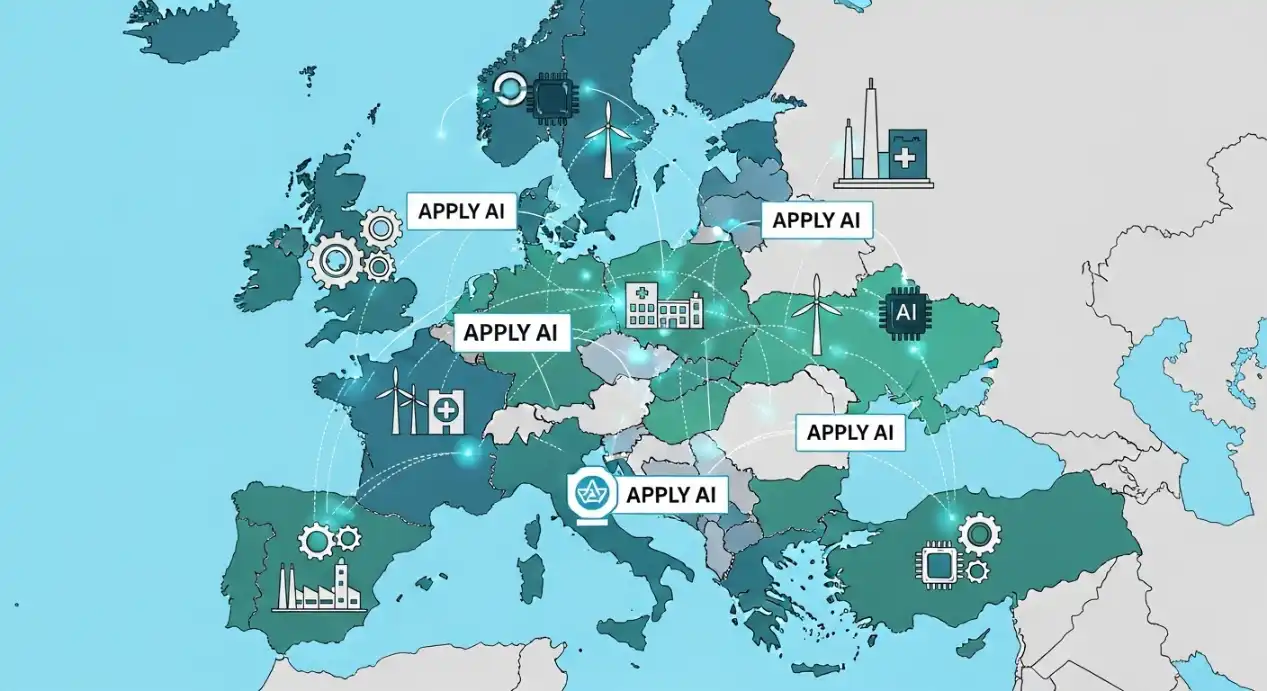Europe just hit the “Install AI” button. The European Commission’s new Apply AI plan earmarks roughly €1.0–€1.1 billion to get practical AI into factories, hospitals, energy grids, and more—so European industry builds with European tech.
What Is the EU’s €1.1B Apply AI Plan?
The Apply AI plan is a fresh European Commission initiative (October 2025) to deploy artificial intelligence in mission-critical sectors—think healthcare, energy, automotive, manufacturing, and pharmaceuticals—to strengthen industrial sovereignty. In plain English: help European companies adopt AI at scale so they’re less dependent on foreign tech stacks and keep more value—and know-how—inside the EU.
The funding pot is about €1.0–€1.1 billion to kick-start projects and platforms, complementing existing EU efforts like Horizon Europe, the Digital Europe Programme, and broader investment umbrellas (e.g., InvestAI and AI Factories). The initiative runs alongside Europe’s AI Act, aiming for fast adoption and trustworthy deployment.
How It Works
At a high level, the Commission coordinates calls and instruments while Member States, regions, corporates, SMEs, and research actors form consortia. Expect three big channels:
- Horizon Europe — collaborative R&I projects (often pan-EU) to prototype, test, and validate AI in real settings (e.g., smart manufacturing, clinical decision support, grid optimization).
- Digital Europe Programme (DEP) — deployment-oriented projects: skills, testing & experimentation facilities, data spaces, and sector platforms to get solutions into production.
- National & private co-funding — Member States and industry can top up to scale winning pilots into EU-wide adoption.
Priority areas spotlight applied AI: computer vision for defect detection, agentic AI for industrial automation, AI “screening” centers in healthcare, and decision support in energy and mobility. The goal is less slideware, more installed AI.
Benefits & Use Cases
- Productivity lift for EU industry — predictive maintenance, quality inspection, process optimization, and supply-chain resilience.
- Healthcare capacity & safety — triage and imaging support, hospital ops optimization, and secure data sharing under EU rules.
- Energy efficiency & grid stability — AI-assisted forecasting, balancing renewables, and reducing wastage in industrial processes.
- Mobility & automotive — ADAS/AV testing, traffic management, and smart manufacturing lines in Europe’s car heartlands.
- SME acceleration — access to shared data/compute, sandboxes, and expertise that small firms can’t build alone.
Costs/Pricing
“Pricing” here means co-funding rates and budget planning for applicants:
- Horizon Europe — typical funding rates: 100% for Research & Innovation Actions (RIA) and CSAs; 70% for Innovation Actions (IA), 100% if you’re a non-profit. Indirect costs are usually a flat 25%.
- Digital Europe Programme — many simple/lump-sum grants co-finance at around 50% (some topics differ; SMEs may see higher rates in specific calls).
Budget tips: build in compute (HPC/sovereign cloud), data governance, integration and MLOps, evaluation/verification, and post-project maintenance. Show credible matching funds and clear KPIs (uptime gains, scrap reduction, time-to-release, etc.).
Local Insights (GEO)
For EU applicants: map your project to national priorities (industrial strategies, smart specialization) to unlock co-funding. Automotive clusters (Germany, Italy), pharma/health (Belgium, Ireland), energy (Nordics, Spain), and advanced manufacturing (France, Czechia, Poland) are well positioned. Engage regional development agencies early for letters of support and facilities access.
For near-EU partners: associated countries can often join Horizon Europe; check eligibility. Supply-chain players serving EU manufacturers can join as tech providers or pilot sites if call rules allow.
Alternatives & Comparisons
- InvestAI & AI Factories (EU): large-scale investment umbrellas (including proposed gigafactories and compute) to complement adoption funding. Pros: long-term infrastructure; Cons: heavier setup, longer timelines.
- National schemes (Germany, France, Italy, Spain): faster local grants/tax credits tied to priority sectors. Pros: speed; Cons: smaller scope, variable rules.
- Non-EU models (US/UK): e.g., NSF/DOE AI institutes or UK industry pilots. Pros: deep vertical focus; Cons: not tailored to EU sovereignty goals or AI Act alignment.
Step-by-Step Guide
- Pick your mechanism: If you’re piloting/validating in real environments, target Horizon Europe IA; for deployment capacity (data spaces, skills, testing), consider Digital Europe.
- Assemble the consortium: Anchor with an industry lead (OEM or Tier-1), add SMEs for niche AI components, universities for methods, and a public partner (hospital, grid operator, city) for testbeds.
- Define measurable KPIs: scrap-rate ↓, OEE ↑, readmission ↓, MWh saved—tie them to EU competitiveness and sovereignty narratives.
- Plan governance & compliance: AI Act risk management, data protection, cybersecurity baselines, and reliable evaluation protocols.
- Budget smartly: allocate for compute, integration, data labeling, evaluations, and change management; verify co-funding eligibility.
- Submit & iterate: answer call criteria clearly, include exploitation plans (post-grant), and line up national/regional top-ups.
FAQs
Is this €1.1B really new money?
It’s a focused package drawing largely on existing EU programmes (Horizon Europe, Digital Europe) and leveraging national/private co-funding to accelerate adoption in priority sectors.
Who should apply first?
Industrial players with near-term ROI: manufacturers with quality or maintenance bottlenecks, hospitals with imaging/ops backlogs, and energy operators needing forecasting/dispatch tools.
What about compute and data access?
Projects can tap EU-backed infrastructure (e.g., HPC, data spaces) and are encouraged to use European cloud/edge stacks where feasible to advance sovereignty goals.
Bottom Line
The EU’s Apply AI plan is not another white paper—it’s a deployment budget. If you can show clear productivity wins and safe, compliant AI, now’s the moment to bring your pilot to the shop floor.
Sources
- Reuters — EU rolls out €1.1B plan to ramp up AI in key industries amid sovereignty drive
- European Commission — European approach to artificial intelligence (Apply AI overview)
- European Commission — Horizon Europe: programme & funding basics
- European Research Executive Agency — Horizon Europe: how to apply & funding rates
- European Commission — Digital Europe Programme: Q&A and funding rates
- Yahoo Finance (Reuters syndication) — EU €1.1B AI plan coverage
- Mobile World Live — EC sets aside €1.1B to fuel AI across industry

